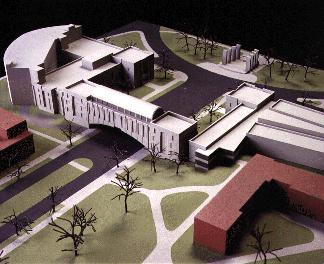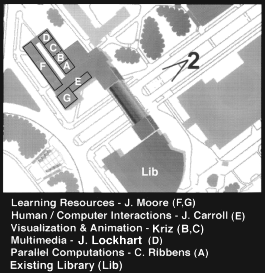The Future
The Future:
- Advanced Communications & Information Tech Center (ACITC)
- ACITC University Visualization and Animation Group (UVAG)
- Scientific Modeling and Visualization Classroom (SMVC)
Advanced Communications & Information Technology Center ACITC
 Virginia Tech is committed to building an Advanced Communications
and Information Technology Center (ACITC) building which is presently under
construction.
To the right is a picture of a tentative model showing how the ACITC building connects
with the current library. One of the ACITC activities is the Library Information
Systems. The link between information technology and the library is the bridge
spanning the present mall in front of the VT War Memorial.
Virginia Tech is committed to building an Advanced Communications
and Information Technology Center (ACITC) building which is presently under
construction.
To the right is a picture of a tentative model showing how the ACITC building connects
with the current library. One of the ACITC activities is the Library Information
Systems. The link between information technology and the library is the bridge
spanning the present mall in front of the VT War Memorial.
Preliminary plans include the creation of nine activities that support the development
or use of information and communications technologies. The ACITC Building will house
nine activities or centers which are listed below along with the respective "ACITC authors".
- Human Computer Interaction: Center /
ISE Laboratory,
John Carroll
- Fiber Optics,
Rick Claus
-
Wireless Communications/Mobile and Portable Radio Group,
Ted Rappaport,
-
Parallel Computing, Cal Ribbens
- Univeristy Visualization and Animation Group:
/ VT - CAVE(tm), Ron Kriz
- Computer Networking, Judy Lilly
- Multimedia and Learning Resources, John Moore
- High Technology Classrooms
- Library Information Systems
Principal Contacts:
- David Ford, Vice-Provost for Academic Affairs, fordd@vt.edu, 330 Burruss Hall
- University Architect, Robert Livingston, Capital Project Manager, Capital Desing
and Construction, Sterret Facilities Complex.
A group of ACITC "authors", Virginia Tech administrators and key faculty planned a
trip to NCSA (Oct95) to discuss possible collaborations
with NCSA that might benefit our respective programs. As a result of our visit to
NCSA we submitted a proposal
to NCSA to become a partner with NCSA in our future activities related to supercomputing,
computer communications and visualization. Our proposal was accepted and Virginia Tech
is now part of the
NCSA-SGI Power Grid Alliance.
This alliance provides training and offers substantial discounts on SGI equipment.
As a result of this alliance NCSA was a partner in Viriginia Tech's NSF CISE
ARI proposal to build a CAVE for the ACITC
and also invited Virginia Tech to participate in the renewal of NCSA as an NSF
supercomputer center for the next ten years: NCSA-Partnership in Advanced Computational
Infrastructure (PACI). Related
to the NCSA-SGI Power Grid Alliance the College of Engineering purchased an I-Desk
system to create the Visualization and Animation Laboratory of Engineering
(VALE)
The ACITC University Visualization and Animation Group (UVAG): "VT-CAVE(tm)"
 In collaboration with NCSA the ACITC University Visualization and Animation Group
(UVAG) will house a "CAVE". We plan on using
the CAVE not only as a research tool but also as a classroom for key lectures that
can benefit from access to these resources.
An
expand view of sections A & B show the details of the lab
and classroom. As a founding member of the CHCI center we plan on working closely with the newly formed
University Center for Human Computer
Interactioni (CHCI) (E). These and other activities, shown in the figure to the
Left, in a top view showing the flow information from the Parallel Computations
Group (A) into the Visualization and Animation Group (A,B). The flow of
information can continue into the Multimedia Lab (D) and the Learning Resources
Lab (F) and the Learning Resources Classroom (G). Together, from this experience,
we will develop appropriate and useful interfaces that will benefit the variety
of educational and research programs both on and off campus. A
vision statement explains how CAVE(tm) technology will be used to build a
bridge between research and education programs at Virginia Tech: Artists will
work with 3D objects just like Biochemists ,who work
with complex 3D chemical structures, Fluid Dynamists, who work with 3D
volumes, and Architects, who walk through 3D structures. Such a center will
serve all Colleges and Departments on campus. An addition to the
Visualization Group is the Animation Group. A
proposal has been submitted to combine the Visualization and Animation Groups
into one. Another addition to the UVAG is the Scientific Modeling and Visualization
Classroom (SMVC) which will be located in the shared Visualization Lab area next to
the CAVE. In the spirit of the ACITC philosophy to link information resources both
on- and off-campus, Visual Numerics Inc. (VNI) and Sun Microsystems Inc. (SUN) has
co-sponsored the SMVC and the SUN/VNI
Java Wave Server in an effort to create a "Distributed Visual Scientifc Computing
Enviornment". Associated with SMVC and its' server is a NSF funded "Combined
Research Curriculum Developement"
(CRCD) project to create an interactive visual computing environment for research
collaboration and curriculum development using Java and Web technologies.
In collaboration with NCSA the ACITC University Visualization and Animation Group
(UVAG) will house a "CAVE". We plan on using
the CAVE not only as a research tool but also as a classroom for key lectures that
can benefit from access to these resources.
An
expand view of sections A & B show the details of the lab
and classroom. As a founding member of the CHCI center we plan on working closely with the newly formed
University Center for Human Computer
Interactioni (CHCI) (E). These and other activities, shown in the figure to the
Left, in a top view showing the flow information from the Parallel Computations
Group (A) into the Visualization and Animation Group (A,B). The flow of
information can continue into the Multimedia Lab (D) and the Learning Resources
Lab (F) and the Learning Resources Classroom (G). Together, from this experience,
we will develop appropriate and useful interfaces that will benefit the variety
of educational and research programs both on and off campus. A
vision statement explains how CAVE(tm) technology will be used to build a
bridge between research and education programs at Virginia Tech: Artists will
work with 3D objects just like Biochemists ,who work
with complex 3D chemical structures, Fluid Dynamists, who work with 3D
volumes, and Architects, who walk through 3D structures. Such a center will
serve all Colleges and Departments on campus. An addition to the
Visualization Group is the Animation Group. A
proposal has been submitted to combine the Visualization and Animation Groups
into one. Another addition to the UVAG is the Scientific Modeling and Visualization
Classroom (SMVC) which will be located in the shared Visualization Lab area next to
the CAVE. In the spirit of the ACITC philosophy to link information resources both
on- and off-campus, Visual Numerics Inc. (VNI) and Sun Microsystems Inc. (SUN) has
co-sponsored the SMVC and the SUN/VNI
Java Wave Server in an effort to create a "Distributed Visual Scientifc Computing
Enviornment". Associated with SMVC and its' server is a NSF funded "Combined
Research Curriculum Developement"
(CRCD) project to create an interactive visual computing environment for research
collaboration and curriculum development using Java and Web technologies.
Presently we are in the process of creating a University Center that can be used by
other off-campus universities/companies and on-campus researchers and faculty. The
Research Division is currently creating advisory committees for CAVE activities that
will provide quidelines for both off- and on-campus CAVE projects.
University Visualization Core Team Members:
- Doug Bowman, Computer Science
- Debby Hix, Computer Science
- David Bevan, Biochemistry
- Bob Schubert, Architecture and Urban Studies
- Ron Kriz, Engineering Science and Mechanics
- Chema de la Garza, Civil Engr.
- Bob Fields, Arts and Art History
- Tim Mack, Entomology
- Joan McLain-Kark, Interior Design
- Cal Ribbens, Computer Science (also ACITC Author of High Performance Computing)
- David Tegarden, Business
- John R. Wenrich, Instructional Technology
Because of the extended interest across campus the "core" group is in the process of
creating a new University Center "Center for Visualization and Virtual Environments",
which will replace the old name University and Visualization and Animation Group.
You can also review a list of
Extended Team Members:
Proposals related to ACITC and the Computer Visualization and Animation Group:
- DARPA: Multidisciplinary University Research Initiative
(White Paper) not funded.
- NCSA SGI Power Grid Alliance (proposal) accepted.
- NSF: Academic Research Infrastructure (White Paper) (Final Proposal) funded.
- NCSA PACI Proposal, Funded. Virginia Tech is a partner with NCSA in the renewal as an NSF supercomputing center.
- NSF Combined Research Curriculum Development
CRCD
- ONR NAVy Collaborative Integrated Information Technology Initiative
(NAVCIITI)
- ONR DURIP Virtual Ships and Ship-Mounted Cranes.
Scientific Modeling and Visualization Classroom
Ron Kriz
This university classroom would directly meet the needs of courses that depend
heavily on sophisticated, hands-on, interactive graphics, scientific visualization,
and virtual reality hardware and software to develop and study models of physical
phenomena. While the facility could conceivably function in an "open" laboratory,
together with the existing Laboratory for Scientific Visual Analysis, mode during
off-hours, thereby benefiting other courses and research, the primary purpose of
the classroom is to provide a sophisticated instructional environment for regularly
scheduled courses. We have submitted an Education Grant Proposal to Sun Microsystems Computer
Corporation (SUN) and Visual Numerics Incorporated (VNI) for additional hardware
and software. Additional funding was provided by VNI to develop a
Distributed Visual Computing Environment
where web based educational tools were created by combining Sun's Java and VNI's
PV-Wave. This collaboration was largley motivated by a student project,
"Scientific
Applications on the Internet: PV-Wave and Java" by Arturo Falck.
In the planning document we
discuss the rationale for such a classroom, outline a proposed system of governance, and estimate the resources needed to
establish and maintain the facility. A final section of this planning document
includes examples of courses which could be taught in the proposed classroom; these
examples were contributed by faculty members from 8 different departments who have
expressed interest in this proposal.
 Return to Visualization Home Page
Return to Visualization Home Page
Virginia Tech
http://www.sv.vt.edu/future/future.html
Created December 1995
Modified February 2001
 Virginia Tech is committed to building an Advanced Communications
and Information Technology Center (ACITC) building which is presently under
construction.
To the right is a picture of a tentative model showing how the ACITC building connects
with the current library. One of the ACITC activities is the Library Information
Systems. The link between information technology and the library is the bridge
spanning the present mall in front of the VT War Memorial.
Virginia Tech is committed to building an Advanced Communications
and Information Technology Center (ACITC) building which is presently under
construction.
To the right is a picture of a tentative model showing how the ACITC building connects
with the current library. One of the ACITC activities is the Library Information
Systems. The link between information technology and the library is the bridge
spanning the present mall in front of the VT War Memorial.
 In collaboration with NCSA the ACITC University Visualization and Animation Group
(UVAG) will house a "
In collaboration with NCSA the ACITC University Visualization and Animation Group
(UVAG) will house a "